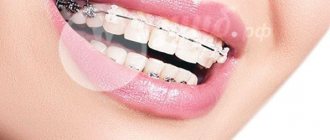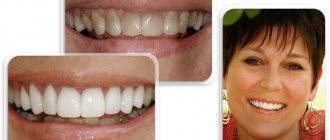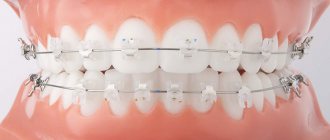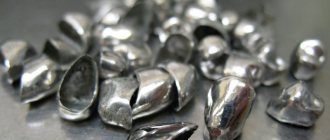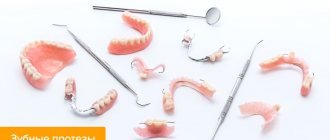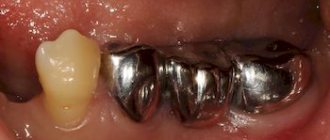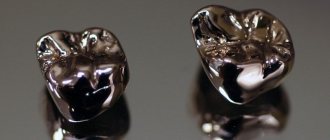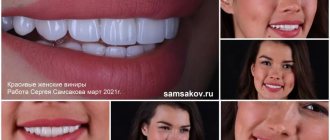Malocclusion is a common pathology that is diagnosed in both childhood and adulthood. Bite correction is a long, complex process, as a result of which the patient receives a healthy and beautiful smile. It is a mistake to believe that malocclusion is solely a problem of appearance, since it generally has a detrimental effect on the condition of the dental system. Malocclusion is associated with dysfunction of the temporomandibular joints, inflammatory gum diseases, and an increased risk of dental caries due to difficulties in hygienic care.
The most popular method of combating malocclusion in modern dentistry is to install braces on the patient. There are several main types of braces on the market, each of which is effective for correcting malocclusion, but has its own nuances of use. Of the budget options, dentists most often recommend metal or ceramic braces. In this regard, many are interested in which braces are better, ceramic or metal. Both options cope well with their main function - bite correction, however, there are some nuances in wear and appearance that must be taken into account when choosing.
Content:
- Features of metal braces 1.1. Pros and cons of metal devices
- Features of ceramics 2.1. The most modern ceramic devices for correcting bites
- What are the similarities between both types of braces?
- Main differences between metal and ceramics
- Is there a compromise?
Today, orthodontists have many modifications of brace systems in their arsenal, differing in a number of parameters.
Since most patients want to correct their bite while maintaining an attractive appearance of their smile, the material from which it is made comes to the fore when selecting an alignment structure. According to statistics, most often clients of dental clinics choose ceramic or metal braces. Let's try to figure out why these devices are in high demand and which ones are better.
Classification of braces
When choosing orthodontic braces, you need to consider the following parameters:
- Material. Braces are made of metal, ceramics, plastic, sapphire, etc. They differ in functionality, durability and service life.
- Aesthetics. Metal braces are visible on the teeth, while plastic and ceramic braces can be transparent or match the color of the enamel.
- Medical indications. Complex orthodontic problems are difficult to correct with plastic or ceramic restorations. In such cases, it is better to install metal ones.
- Duration of orthodontic treatment. It goes faster if you install metal structures.
Braces are divided not only into metal and ceramic, there are other varieties, but these two types are the most common. Orthodontic structures are also classified on other grounds, for example, the method of fixation: ligature, non-ligature, removable, self-adjusting, etc.
The choice of design is determined by medical indications, but often the dentist invites the patient to choose the material from which the orthodontic brackets will be made. To make it easier for you to decide, we will tell you which braces are better - ceramic or metal, and what advantages and disadvantages they have.
Features of metal braces
Metal devices are rightfully recognized as the most reliable and durable. They have a budget price that doesn’t hit the consumer’s wallet so hard, and they do an excellent job of their functions. But there is one “but” - they don’t look attractive at all.
To improve their appearance, developers began to use alloys with a special Teflon coating in the production process. The latter gives the device a light tint, making its elements less noticeable to others.
Metal devices can be:
- ligature;
- self-regulating.
The first ones are presented in a rich range of colors, so teenagers love to experiment with them. When wearing them, you need to visit the orthodontist approximately once every 1-3 months. The duration of bite correction takes up to two and a half years.
Self-adjusting devices are smaller than ligature ones, but their locks are thicker. They are easier to care for. They usually cost more.
Pros and cons of metal devices
A person studying the features of ceramic and metal braces is usually interested in the advantages and disadvantages of these types of systems.
In this case, the advantages include:
- very reliable fixation;
- resistance to all types of food dyes (do not stain);
- the ability to quickly correct existing crooked teeth;
- low risk of breakdowns;
- smooth surface, pleasant to the touch;
- decent hygienic characteristics;
- reasonable cost.
The disadvantages of metal devices are:
- not very beautiful appearance, due to which the patient may experience psychological discomfort;
- may cause allergies if a person has individual intolerance to metals.
Constructions made of plastic and artificial sapphire
The cheapest devices are plastic. The design is safe, lightweight, and practically invisible on the surface of the row, as it is made of transparent polymer. But such braces are prescribed only for mild pathologies; for complex malocclusions, plastic is not suitable. The disadvantages include the fact that the material quickly loses its attractiveness, as it is stained with food or tobacco.
Synthetic materials are also used to make sapphire structures. The basis is an artificial crystal that maintains transparency throughout the entire treatment period. The durability of the device is higher than that of ceramic, plastic and metal models. When installed and worn, the locks are not visible, which means psychological discomfort is eliminated. This option is also suitable for Patients involved in sports who need “invisible” correction. Installation of the system is indicated for small coronal parts, when fixation of other options is contraindicated. But the cost of sapphire structures is higher than others.
Combined devices
For correction, complex hybrid structures of the following types can be prescribed:
- metal-ceramic devices;
- lingual-vestibular models with partial placement of structural elements on the inside of the row;
- metal-sapphire braces;
- with the function of self-adjustment of ligatures and others.
There are many options; the choice of design depends on the condition of the row and the complexity of the pathology. A special feature of combined devices is that they combine functionality, aesthetics, strength and reliability. But in order for the treatment to be effective, the Patient is required to comply with the following rules of care:
- regular brushing of teeth, including after meals (at least twice a day);
- use of brushes with soft and medium bristles, special brushes, irrigators to completely remove food debris;
- rinsing the mouth using rinses with antiseptic properties;
- regular visits to the dentist for preventive examination and correction of the apparatus, treatment of diseases when they arise;
- cleaning from plaque and stone in an office environment.
Hygiene products are available in pharmacies or dental clinics. It is recommended to choose products designed for orthodontic structures, for example, specially shaped brushes with tufts for high-quality removal of plaque and food debris.
After completing the course of treatment, the Patient must wear retainers, which consolidate the achieved results and prevent the row from returning to its original state. The duration of use of such overlays varies; it is determined by the doctor depending on the initial defect, the condition of a number of other factors.
Features of ceramics
Ceramic devices were created specifically for patients who are accustomed to having a perfect smile. In color they almost completely match the enamel, so they are hardly noticeable to others.
Like metal analogues, they come in:
- ligature - fixed on the front surface of the dentition;
- non-ligature - adjustable using special clips.
Among the undeniable advantages of ceramics, orthodontists name:
- excellent hygiene;
- good aesthetics;
- absence of bulky locks;
- sufficient strength.
They do not provoke allergies, and therefore are an ideal solution for allergy sufferers.
At the same time, they are less durable than metal ones, and break more often; they can be painted with food coloring. They are larger in size than metal ones. They cost more.
The most modern ceramic devices for correcting bites
Damon Clear ceramics are in high demand among patients today. Its distinctive feature is one hundred percent resistance to pigmentation. Reflection devices from Ortho Technology have also proven themselves well. They are made from special aluminum oxide polycrystals and do not leave stains on tooth enamel or cause discoloration.
The Mistique GAS designs are considered a worthy option. They are coated with silicon oxide, and therefore also do not absorb coloring particles and maintain the natural color of the enamel.
Sapphire and plastic braces
Plastic staples are considered the cheapest. Light, safe and invisible, as they are completely transparent. Their disadvantage is that they are not suitable for severe dental diseases. In addition, they are not as durable as metal or ceramic braces. Also, plastic products may darken over time if a person often drinks drinks with coloring substances.
Sapphire structures are made from synthetic sapphire, which remains perfectly transparent throughout the entire time you wear braces. In addition, sapphire systems are much stronger than metal, ceramic and plastic. There is virtually no risk of breakdowns. Designs made from synthetic sapphire are suitable for people who need “invisible” treatment or play sports. Also, sapphire braces, which have small locks, are convenient to install for patients whose lower teeth are small. The only disadvantage of such systems is their high cost.
What are the similarities between both types of braces?
Both devices cope perfectly with their main function - eliminating even severe tooth curvature. Both metal and ceramics cannot be installed if:
- untreated caries;
- the presence of deep cracks on the enamel surface;
- the presence of implants, crowns, bridges;
- oncology.
Both systems cause discomfort during the adaptation period. After each successive tension of the arch, a person experiences pain for several days.
Metal
The first metal braces for correcting malocclusion pathologies appeared back in 1955. Since then, the principle of their operation has remained virtually unchanged, but the designs have been refined and improved, and now wearing them has become more comfortable and convenient. Most often, titanium, stainless steel or nickel are used for their manufacture today.
The main difference between metal products and ceramic products is their high strength. In addition, you can achieve the desired result much faster. It is almost impossible to deform such staples, so they are often installed in adolescence. The metal is not susceptible to dyes, so it is an excellent option for treating patients who like coffee, tea, or smoke a lot. The staples do not darken or rust even with prolonged use, and their cost is several times lower than that of ceramic analogues.
The disadvantages of metal include unattractiveness and the risk of injury to the mucous membrane due to careless handling and during the adaptation period. Such braces are not suitable for allergy sufferers in case of individual intolerance to certain types of metal.
Main differences between metal and ceramics
If we compare the described products with each other, then we need to focus on four main factors:
- Reliability. According to this criterion, metal devices win.
They can easily withstand any mechanical stress, so they remain intact throughout the entire treatment period. Ceramics is inferior in strength, but when used correctly (if the patient strictly follows all medical recommendations) it also wears quite well. However, it is not recommended for professional athletes to install it. - Appearance. Ceramic braces are unnoticeable. They almost match the natural color of the teeth, so they are suitable for people who lead a public lifestyle and speak in public. Metal does not look as aesthetically pleasing and creates a pronounced contrast on the dentition. However, if you plan to use it, you can ask the orthodontist to use arches that are fixed on the inner surface of the teeth. But they are so expensive.
- Price. Ceramic devices are inferior here - they are more expensive, so not every patient in a dental clinic can afford such treatment. Metal has a more reasonable price. This is its main advantage.
- Convenience. According to user reviews, ceramics cause slightly less discomfort. Therefore, if a person has a low pain threshold, he should give preference to braces made of this material.
In any case, the final decision must be made together with your doctor. After all, the main goal of orthodontic therapy is to give certain teeth the correct position. And the emphasis in this situation should no longer be on beauty, but on functionality and a guarantee of obtaining the expected result in the shortest possible time.
Correct bite: 100% beautiful smile
Occlusion is the interaction of the upper and lower dentition when the jaw is closed. Disturbances in the formation of bite lead to accelerated wear of the tooth enamel of the incisors, canines and molars. Orthodontists will help create a beautiful smile and improve a person’s psychological state.
If you have problems with your teeth, please contact our clinic. We use modern technologies to gradually change the position of teeth and give them the best position.
Please note: According to statistics from the international health organization, about 80% of residents of developed countries have an incorrect bite. Sometimes such problems are cosmetic in nature, but there are also serious deviations that require the intervention of specialists.
Is there a compromise?
For clients who can’t decide whether to choose ceramic or metal braces, dentists today can offer a compromise option. Its essence is to install ceramic devices on the teeth located in the smile zone, and metal ones on all others.
This combination allows you to make the cost of orthodontic treatment more affordable, preserve the aesthetics of your smile and obtain excellent therapeutic results.
Remember: braces are just a tool in the hands of a doctor. An experienced doctor knows how to eliminate a patient’s defect using different types of devices. But he offers exactly those that will make your smile more attractive more quickly and less traumaticly. Therefore, trust your doctor and strictly follow all his instructions. By following this rule, you will correct your bite very quickly.
What is the difference between ceramic braces and metal braces?
| Metal | Ceramic | |
| Price | From 70,000 rubles for one jaw | From 150,000 rubles for one jaw |
| Efficiency | Coping with the most difficult cases | Less effective for complex malocclusions |
| Aesthetics | Low – the fact of orthodontic treatment cannot be hidden | High - almost invisible from the outside |
| Size | More bulky, so it takes longer to get used to | Small neat plates-braces |
| Safety | May cause an allergic reaction and irritation of sensitive gums | Completely safe |
| Design | There are both vestibular and lingual | Vestibular only |
Ligature or non-ligature braces – which is better?
Which braces system should you choose for effective correction - ligature or non-ligature? Specialists at the Vanstom clinic often hear this question from their patients, and therefore below we will try to answer it in detail and clearly.
Ligature braces differ from self-ligating braces in that they have a special wire or elastic band as a fastening mechanism. Ligature-free braces are fixed in the patient’s mouth with clasps, which ensure strong fixation of the product in the oral cavity. The material for making self-ligating braces can be almost anything: metal, porcelain, combined variations. Basically, this type of structure is produced by foreign brands and this partly determines their high market value.
Advertising suggests that self-ligating braces are the most effective option, but this is not true in all cases. To make the right choice of braces system, it is important to compare them with each other in terms of performance characteristics.
Possibility to change the type of bracket ligation
This possibility is important for the treatment of malocclusions with brace systems and only ligature-type designs have it. When using ligature braces, the orthodontist at any time during the course of correction can replace one type of structure fixation with another, which will be optimal when certain positive changes are achieved. Self-ligating structures do not provide such an opportunity, since they initially provide for one type of fixation system - active or passive. And this is fraught with at least an increase in the overall correction time.
Frequency of visits to the orthodontist while wearing braces
The same advertisement assures – choose expensive non-ligature braces and you won’t have to constantly go to the dentist. But in reality, the situation is exactly the opposite: self-ligating structures do not allow you to simply change the type of fastening of the arch base, and therefore the doctor will need to change the arch itself.
You can also hear that non-ligature braces are safer for patients, since the pressure they create is less than that of ligature systems. But this is an exaggeration: there is practically no difference in the degree of load between the types of structures under consideration, and these data are confirmed by a number of studies.
Based on the information presented, we can draw a simple conclusion - ligature-free braces are by no means the best option for the system. Yes, they are somewhat easier to care for, but the treatment process using this type of braces is more complex, specific, and, taking into account the price of self-ligating braces, more expensive for patients.
